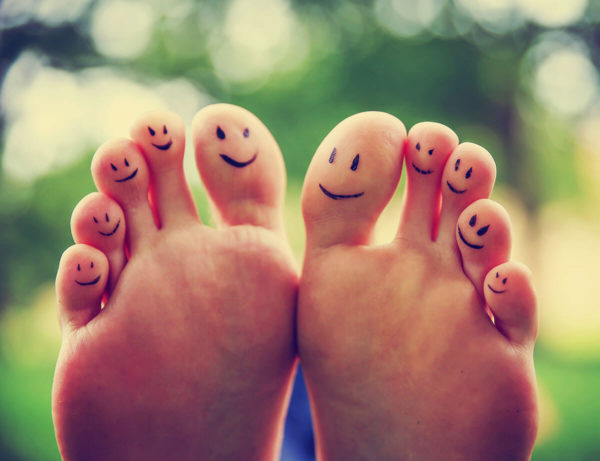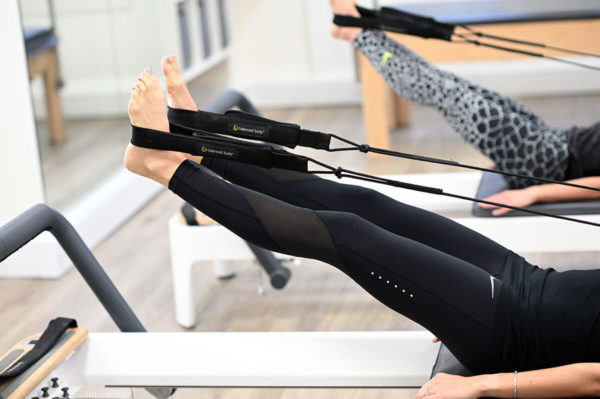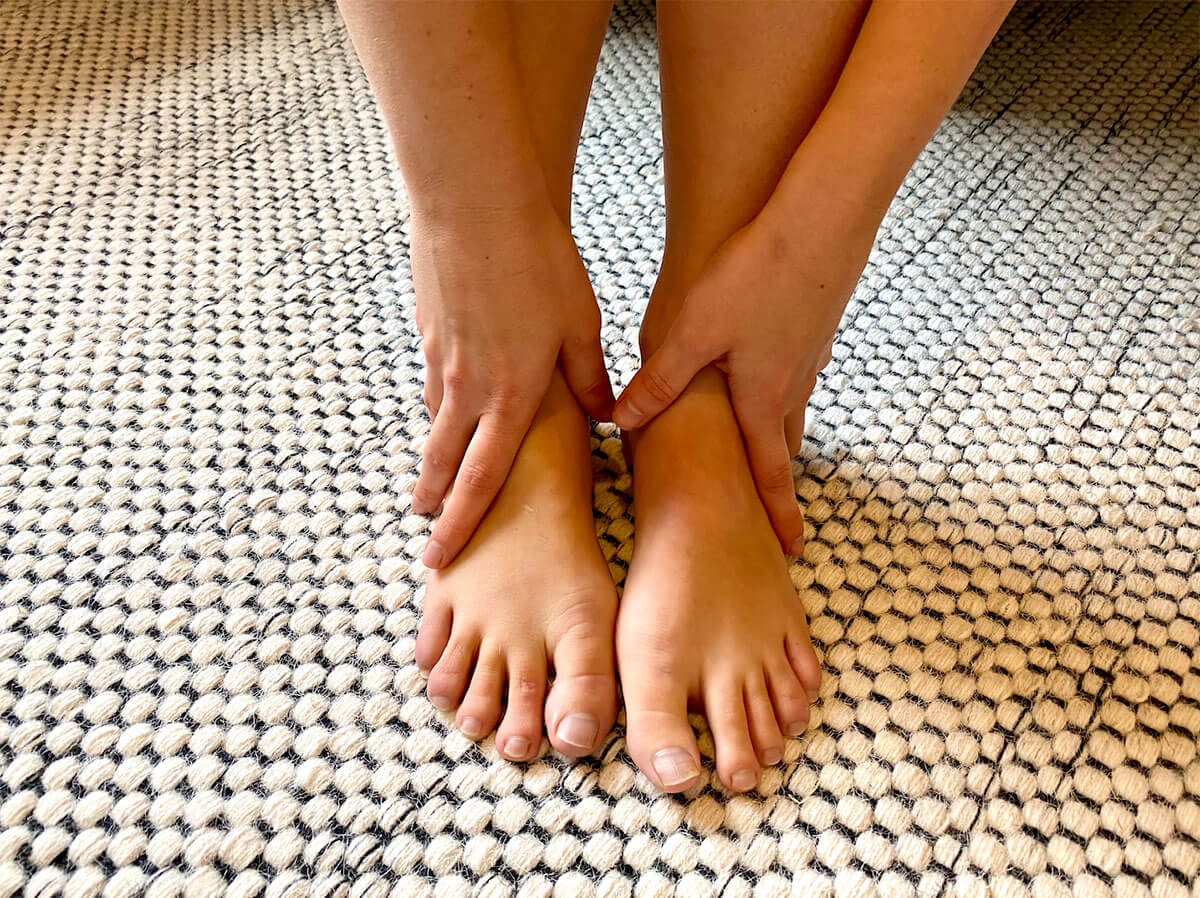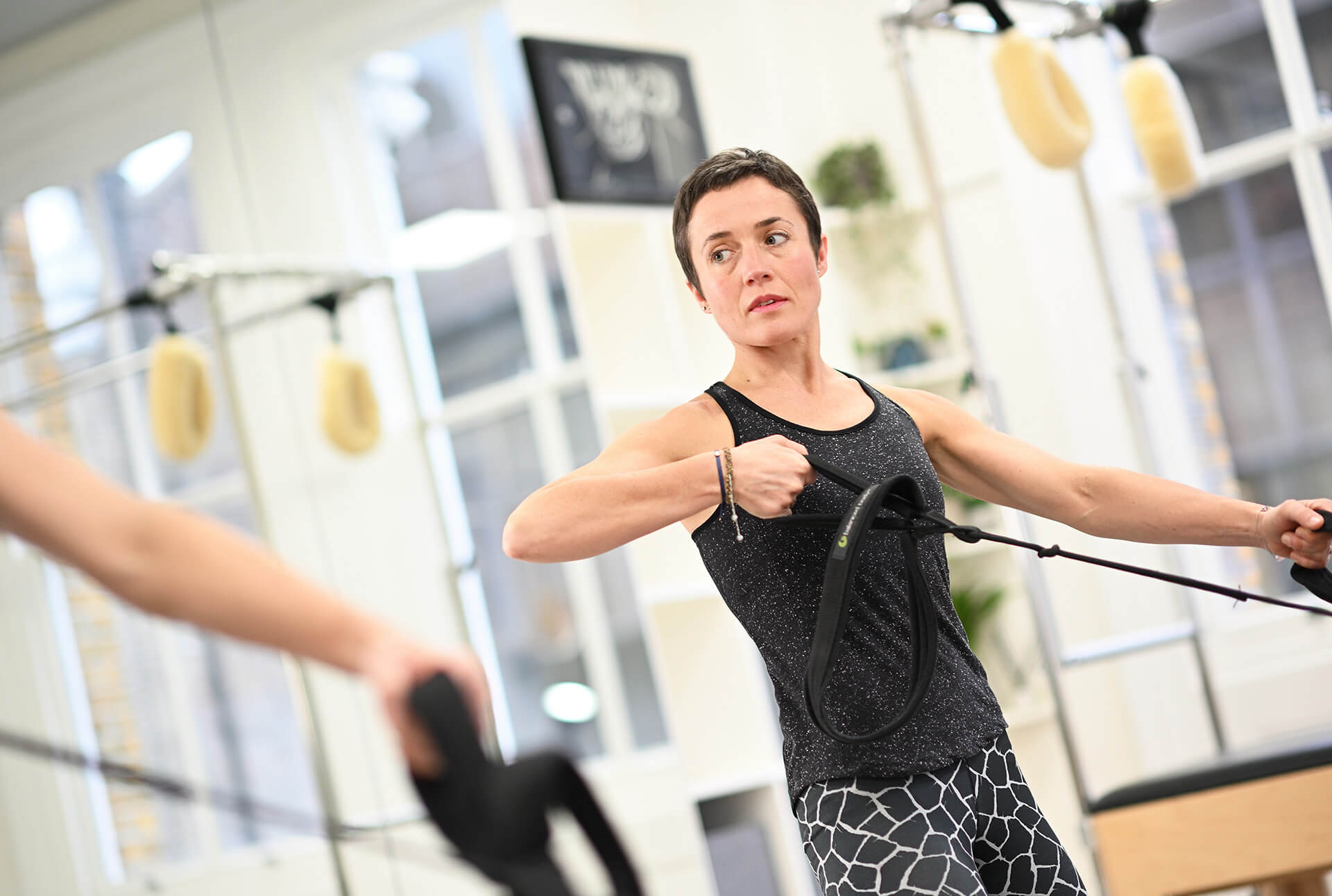Key Contributor: Ami Odendaal, Chartered Physiotherapist
We want to demonstrate how you can strengthen your feet with simple yet effective exercises. Often, we focus on other much larger parts of our body in a bid to tone and build strength, however, it’s just as important to strengthen your feet as it is your legs, arms and back.
Feet are the foundation of the body. They are our base of support and are responsible for keeping us upright. They also work to keep hips, knees, and even shoulders in good alignment.
Because of the important role they play, feet need to be strong, supple and balanced. But keeping them in tip top condition isn’t easy. Even everyday things like wearing rigid shoes all day long leave them stiff and weak.
So, how do we combat the negative effects of modern life and optimise our foot health? Well, as with the rest of the body, exercise and self-massage is the answer. Plus, practising Pilates regularly also helps.
However, if you tend to neglect this part of your anatomy – despite toning your bum and abs – then you’re not alone.
Most people are guilty of doing so, which is partly why foot pain and injuries (like plantar fasciitis) are so common these days.
Luckily for you, Complete Pilates are going to show you how to strengthen your feet, with motivation to do Pilates foot exercises to strengthen your feet. So, keep scrolling. Because our team is here to educate you on why your feet need exercise!
Awareness is the First Step
Only think about your feet when you get the occasional pedicure? Then it’s time to get properly acquainted with them.
So, take a second and tune into your feet. In standing, is your weight more on one side than the other? Is one foot rolling inwards or outwards? Is there more weight on your toes or heel?
Also, take a lot at your feet and have a feel. Do they feel sore to touch on both the top and bottom? Have you got any ingrown toenails or lots of dry skin? Have you got any verrucas? Do your toes relatively straight or do they claw?
Problems in your feet can have a disastrous effect on the alignment of the whole body. This means that, if you do discover discrepancies in your feet, it’s important to find the cause and correct it.
Ignoring alignment issues – or failing to fix them by attending Pilates classes – can eventually lead to weaknesses and injury.
Read on to find out the common problems and how to strengthen your feet with some simple exercises.

Your Feet: The Common Problems
1. Weak Feet
Most people mistakenly believe that the foot has one arch. In fact, the foot has three: one along the width of the foot and two on either side of the length of the foot.
These arches are formed by the tarsal and metatarsal bones, which are supported by the ligaments and tendons in the foot. There are 4 layers of muscle in the foot! A length of thick connective tissue called the plantar fascia also supports these arches.
When these muscles weaken (which could be because of sudden weight gain, constantly wearing bad shoes or injury), the arches “fall” and people notice they have ‘flat feet’. Flat feet are not a problem, however weak flat feet are!
What are the problems associated with fallen arches?
The arches of the foot act in a spring-like way to absorb the shock of the ground forces when walking or running and push you off again. And these are serious forces to contend with. Just walking creates a ground force of more than 1.5 times your body weight while running increases this to at least three to four times body weight.
With this in mind, it’s easy to see why, without these structures, the body is at greater risk of an injury.
Weak arches can also lead to the foot rolling inwards, called over-pronation. This is a big topic to cover but can also bring its own set of problems.
2. Stiff, immobile feet
The foot is a dynamic structure. It is made up of lots of bones – 26 to be precise – and more than 100 muscles, ligaments and tendons.
These structures are what allows for the body to make constant adjustments to adapt to different surfaces. This is what protects you from falls and injury.
Although people often worry about their feet pronating, feet need to be able to pronate (roll inwards) to absorb the shock of landing on hard ground when you walk or run. As well as being mobile they also need to act as rigid levers to push you off!
All of this means that – like with the rest of the body – feet need to be flexible as well as strong and stable.
In our barefoot state, feet naturally develop these strong, supple muscles that can adapt to the environment quickly.
The problem is most people are stuck in either restrictive footwear or cushioned shoes with orthotics (foot supports) most of the day. These prevent feet from moving naturally and freely. Structured shoes also prevent toes from spreading out to support us.
Why are inflexible feet a problem?
“Your feet are the contact point with the ground and have to mould and adapt to what’s underneath them to make sure you stay balanced,” says O’Leary. And, as we’ve established, they play an important role in absorbing forces when you walk and run.
But if feet are stiff or weak, they can’t effectively react or absorb the impact from the ground. When this is the case, your chances of sustaining an injury when you walk or run, are greater.

3. Poor Proprioception
Your feet are amongst the most nerve-rich of anywhere in your body (the sole of one foot has over 200,000 nerve endings!).
And there is a good evolutionary reason for this – feet are our contact with the ground. This means that sensory information is sent from them to the brain, and from the brain to the body. This is what allows us to adapt to our surroundings as we walk.
This kind of nerve communication is called proprioception and is vital for protecting us from falls. Good foot proprioception also helps us move in the most efficient and agile way.
However, when the body’s natural process of proprioception is impaired, problems occur. This most often happens as a result of injury to the foot and certain illnesses. Studies on barefoot running suggest that even thick-soled trainers can negatively affect these senses.
Why is poor proprioception a problem?
Without good proprioception, we are prevented from reacting properly to the surface we are walking on. In turn, this stops us from altering our gait or foot position appropriately.
As a result, we are at a greater risk of falls or of damaging the foot or lower limbs.
People with multiple sclerosis, for instance, often have poor plantar-sensory feedback (the sensation on the soles of their feet). This affects their proprioception, and as a result their gait and balance.
Proprioception impacts sports performance
Poor proprioception is a big issue for keen sportspeople.
Take running, for example.
Although human beings are designed for this sport, the injury level among runners is surprisingly high. In fact, reports show that 30 to 50 percent of runners suffer an injury over the course of a 12-month period.
These statistics are especially surprising given the large number of people wearing supportive, high-tech running shoes.
However, new research makes more sense of these findings. Because, the research suggests, these shoes may actually be causing some of these injuries. How exactly? By getting in the way of plantar-sensory feedback.
How does footwear affect sensory perception?
At this point, there is little conclusive research in this area. But, the evidence we do have suggests that thick-soled, restrictive running shoes are interfering with sensory input.
This is important because plantar-sensory feedback sends important information to the brain about the strength of ground forces underfoot.
In turn, this helps the person running to modify their technique to cope with the impact. By wearing certain shoes (or so the theory goes) these protective mechanisms are prevented from kicking-in. And this is where the danger for runners – and their feet – lies.
Pilates Foot Exercises to Strengthen Your Feet
1. Go barefoot
Although not a direct exercise to strengthen your feet, feet stuck in rigid shoes all day become weak and unstable. So, one of the simplest things you can do to start strengthening your feet is to take your shoes off.
NB: This might not be advisable if you’re suffering from a foot injury like plantar fasciitis which often requires a bit of support in the acute phases.
How to strengthen your feet: If you’re used to being in shoes all day, chances are your feet might ache a bit when you start to go barefoot. Ease yourself in by spending short periods of time barefoot at first to build up your tolerance.
Signing up for Pilates classes is also helpful. Pilates is always performed without shoes, which makes attending them regularly a great way to ensure you spend time shoeless.
2. Doming, or short foot
This move works the arch muscles as well as most of the muscles on the underside of the foot. This exercise also helps strengthen important muscles of the inner side of the foot to help support the arch.
How to strengthen your feet: Start by sitting with your feet flat on the floor. Tighten the muscles in the sole of your foot by pressing the toes into the floor and trying to lift the arch. Try to keep the toes uncurled and the ‘knuckles’ of your toes (metatarsals heads) flat. By keeping the balls of your feet pressing into the floor, you will work more in the arch. Hold with the arch raised or “domed” for a slow count of 3. Release and repeat 10 times.
3. Flex and Point
This foot strengthening exercise is great – and done slowly can be really challenging – way to mobilise your toes, arches and ankles.
How to strengthen your feet: Start by flexing the toes towards you. Then pull the ankle towards you. Next, curl the toes, keeping the ankle pulled up, then point the foot, trying to curl the toes even more.
Keeping the ankle pointed, flex the toes, then ankle, point the toes, then ankle.
Repeat this in both directions so that you feel the stretch and movement throughout the top and bottom of your foot.
4. Foot stretches
Make sure to do this exercise in sitting so that you do not put too much pressure through the foot! This is an advanced level stretch so is not always recommended for everyone! Check with us before you try it as it may not be suitable if you have an injury.
The advantage of this is that you can stretch both the top and bottom of your foot.
How to strengthen your feet: In sitting, bring one foot underneath you and flex your toes under, trying to get the bend at all the joints in your toes. Pause there for a second and then uncurl the toes and lift the heel to stretch the underside.
5. Big toe spread
This is a great exercise to reclaim the space between your toes and strengthen your foot.
If you have a bunion, particularly if it is painful, please check with your treating clinician or contact us to make sure that this exercise is suitable for you.
How to: In sitting, press the 4 toes into the floor and try to lift and place the big toe out to the side before returning it in.
If this is too difficult, press the big toe into the floor and try to move the 4 toes away from the big toe. This is a more passive version and will help you build up to it.
6. Toe curl or lumbricals
This exercise is often given out to strengthen your feet and often done badly! The aim of this exercise is to strengthen the intrinsic lumbricals in the under surface of the foot. This means that you do not need a towel to curl up as often that means you work more externally.
By curling your toes it is more of a toe scrunch and will not help these deeper muscles.
How to: In sitting, press the toes into the floor and try and lift the ‘knuckles’ of the toes (where the toes meet the foot). The toes should remain flat rather than curling under.
Repeat this 10x slow and 10x with a hold.
If you have painful feet or an acute injury please get it touch with us before doing this exercise to make sure it is right for you.
Pilates for Plantar Fasciitis: What is Plantar Fasciitis?

The plantar fascia is a band of connective tissue on the sole of the foot, that stretches between the heel bone and the base of the toes. It supports the arch of the foot and acts as a shock absorber as we walk and run.
In plantar fasciitis, the plantar fascia thickens and becomes inflamed. This causes heel pain, which could extend into the arch of the foot. The pain typically develops over a period of time and is felt when putting weight through the heel in standing and walking. It tends to be worse in the morning and when standing up after longer periods of sitting, and often gets better when moving around throughout the day.
You could develop plantar fasciitis if you are a runner, if you exercise on hard surfaces or if you have a high BMI. You are more susceptible if you have flat feet and wear shoes with poor support.
In two out of three individuals, x-rays will show a heel spur, or a bony growth under the heel bone. However, having a heel spur does not always cause pain or mean that you will develop plantar fasciitis.
How Can Pilates Help Plantar Fasciitis?
When treated, plantar fasciitis may take a couple of months to resolve, but it may take longer for some. If left untreated, plantar fasciitis can persist and some studies have shown that 40% of individuals may still have symptoms after two years. Treatment includes temporary activity modification, for example reducing training loads if you are a runner, or reducing the number of hours on your feet, especially when this is required at work. You should gradually return to these activities as the pain allows. Losing weight in the case of individuals with high BMI, helps to reduce the load taken through the heel.
Applying ice, resting and wearing comfortable shoes may provide short-term relief, but exercise can help to shorten the time it takes for the condition to resolve. Pilates can address the presence of foot and lower leg muscle weakness to support and reduce the stress on the plantar fascia.
Best Pilates Exercises for Plantar Fasciitis Relief
1. Ball Rolling
You can use a tennis or trigger point ball to roll the bottom of your foot. Spend 3-5 minutes gently rolling between the heel and the base of the toes.
2. Toe Yoga
Strengthen the intrinsic foot muscles that help to stabilise the foot and support the arch.
3. Foot Massage & Plantar Fascia Stretch
Massaging your feet regularly can help to relieve tension in this area. You can gently rub the under surface of your foot but also make sure you massage the top of your foot, including between the toes. This will help the sensory nerve endings wake up. If you have pain, start with lighter pressure, for around 5 minutes a day.
To stretch the plantar fascia, place the ankle of your affected foot onto your other thigh while sitting. Hold your big toe and gently pull upwards, to feel a stretch under your foot. Hold this position for 10 seconds and repeat 10 times. Do this 3 times a day.
4. Calf Raises with Rolled Towel
Place a rolled-up towel under your toes while standing. Holding on to a steady surface for balance, slowly raise and lower your heels in a controlled manner. Complete 12 repetitions and repeat two more sets after a short break.Do these every other day and progress to the next version of the exercise when double leg heel raises no longer fatigue the calves after 12 repetitions.
If you’re able to complete these easily and pain free, you can try some of these progressions below.
- Single leg lowers: Progress your heel raise with physio led Pilates: Single Leg Lower
- Single leg calf raises: Physio Led Pilates for Calf Strength: How to do a single leg heel raise
- Double or single leg calf raises on a step
- Single leg heel raises wearing a weighted backpack
If you try these exercises at home, it is safe to feel your familiar heel pain while doing them, but stop to rest, or choose a regression of the exercise if you feel more than 4 out of 10 pain (mild and manageable pain). As always, if you have an injury or persistent pain it’s important to review with your doctor or Physiotherapist before starting or continuing exercise.
Understanding Your Feet Better?
Your feet are one of the most important parts of your body and strengthening your feet is key if you want to have a strong and balanced body. Too often we squeeze them into tight shoes and don’t spend enough time looking after them. These simple exercises are great to do at home so that your feet can get more TLC!
At Complete Pilates, our clinical Pilates instructors and physiotherapists have a huge amount of knowledge in how to get your feet working well. We also work alongside incredible specialist clinicians, such as Jane Baker, if you have any injuries which need more attention.
Please remember, if you have any acute foot pain, have noticed any deformities around your toes or feet or are constantly rolling your ankle, it is important to get a full assessment before starting these exercises to make sure that they are right for you.
The best part about these exercises is by doing them little and often you will make more of a change than doing lots in one go. Consequently, you do not have to warm up and can just do them when you sit down to work or have a cup of tea!
If you want to improve how your feet feel and function, you can find us at one of our Pilates studios in London. If you’re looking for more information and want to speak to us about your muscle recovery, how Pilates can help and what classes we offer, please get in touch online or contact us on 0203 764 5668.
You can find us at Complete Pilates in Angel or any of our conveniently located studios (see our Chelsea Pilates studio or our Pilates studio in London City).
Education is key:
These blogs are designed to give information to everyone, however, it is important to remember that everyone is different! If you have not seen one of our therapists and have any questions about injuries, what you have read or whether this may be useful to you, please just ask. We are more than happy to help anyone and point you in the right direction. Our biggest belief is that education is key. The more you understand about your injury, illness and movement, the more you are likely to improve.





